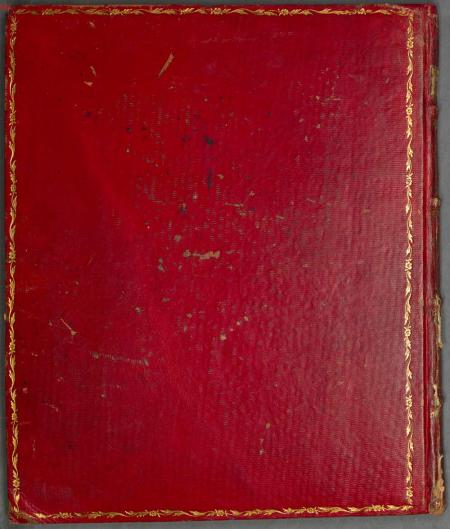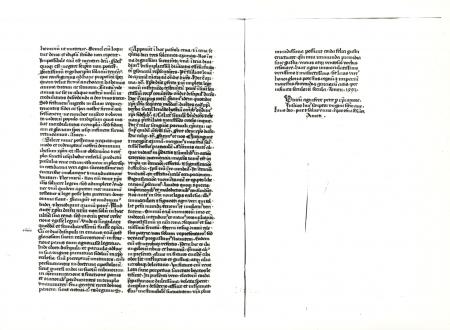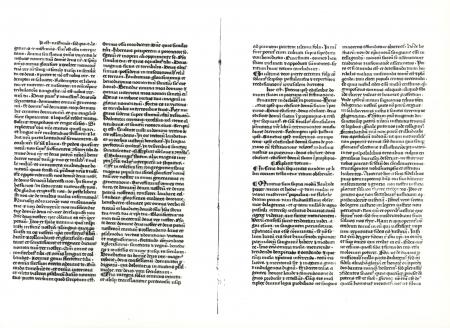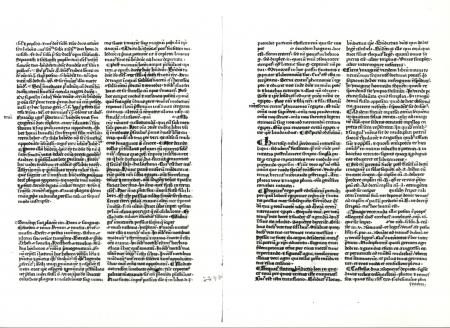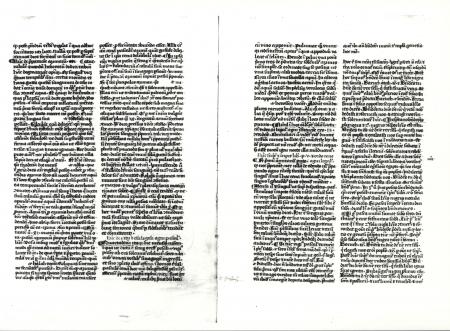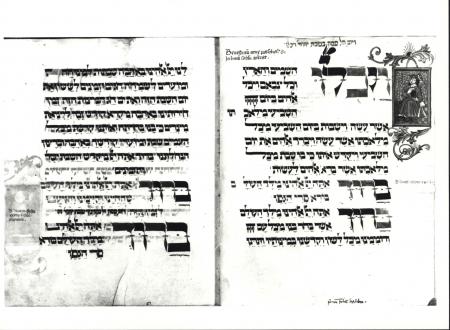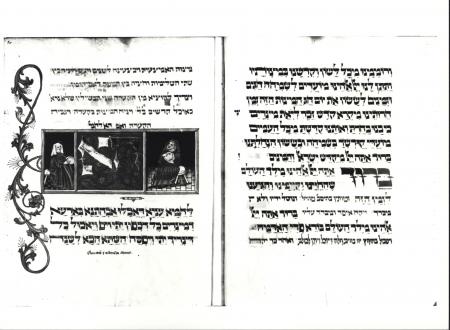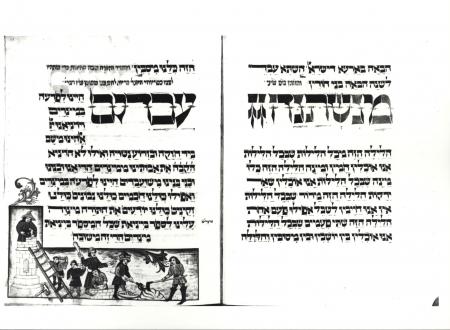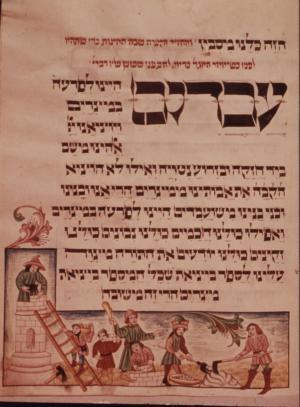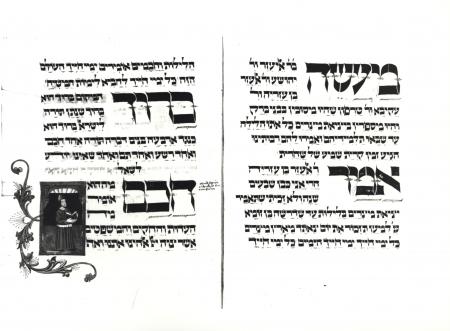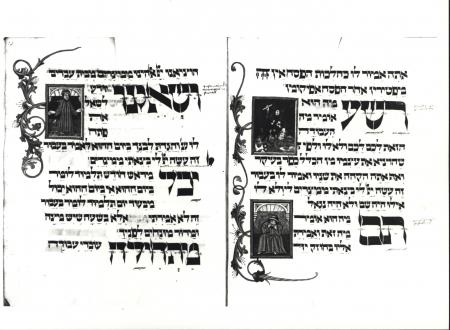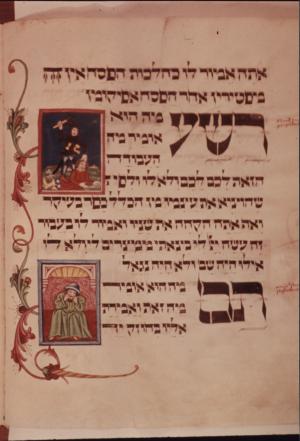Obj. ID: 19960
Hebrew Illuminated Manuscripts The Tegernsee Haggadah, Germany or Austria, before 1489

A Passover Haggadah of Ashkenazi rite was copied by Joseph son of R. Ephraim, who wrote his name twice: once at the bottom edge of the last verso of the manuscript (fol. 36v); and the second time within the panel depicting Rabbi Akiva as the Wise Son (fol. 12).
The decoration programme consists of four large painted initial word panels for some of the main sections, and twenty small painted panels, of which only four are placed within the text space (fols. 12, 12v, 13, 15v) and the rest are in the margins, depicting traditional ritual and textual illustrations, as well as one eschatological depiction of the Messiah entering Jerusalem, illustrating the text "Pour out thy wrath" (fol. 24v). From all but three panels issue a pair of long-stemmed fleshy acanthus leaves, sometimes curling and often enhanced by gold buds, thorns and floral motifs.
The figures within the panels are placed either in a meadow (fols. 8v, 12v (upper panel), 15, 18 (upper panel), 24v) or in rooms with tiled floors, wooden ceilings and arched entrances (fols. 7v, 10, 12, 12v (lower panel), 13, 17, 17v, 18 (lower panel) 18v, 20v, 21, 21v). They are squat and richly dressed in robes and mantles, the drapery folds rendered with darker tones of the same colour, and highlights of either white or yellow. They wear varying kinds of opulent head-gear: high caps (e.g. fols. 8v, 11, 12), a head gear recalling a bowler hat (e.g. fols. 12v, 16), hats divided horizontally into two or three sections (e.g. fols. 18, 21v) with an extension (e.g. fols. 11, 20v), and Jewish hats (fols. 7v, 24v). The women wear white wide kerchiefs tied under the chin (e.g. fols. 10, 21v). Hands, hair and facial features are outlined in black ink; the irises are mostly looking sideways.
Style
The style of the manuscript poses a serious problem. On the one hand no exact parallel has yet been found for the style of the figures in the panels. On the other hand, the style of the acanthus scrolls which issue from them was very popular in the last quarter of the 15th century and appears in many manuscripts which were produced in the Danube region of South Germany andAustria. A united figure and foliage style similar to that of our haggadah, if found, could indicate a specific workshop or place where the paintings were executed.
We are deeply grateful to the scholars of the Österreichische Akademie der Wissenschaften, Kommission für Schrift- und Buchwesen des Mittelalters, Otto Pächt-Archiv at the Institut für Kunstgeschichte of the University of Vienna (Drs. M. Roland, Ch. Beier, A. Tif), the head of the Manuscript Department of the Österreichische Nationalbibliothek in Vienna (Dr. A. Fingernagel), as well as to colleagues in the Manuscript Department of the Bayerische Staasbibliothek, Munich (Drs. B. Hernad and K.-G. Pfändtner), for their helpful comments and examples. Being familiar with this regional style through wide research and publications, they suggest that at this stage of research we should agree on a general definition of the region for the style of our haggadah, namely the Danube region of South Germany and Austria.
Despite that, a close stylistic comparison for the acanthus scrolls pointed out to us by Dr. Roland is found in a Breviary produced for Brixen Diocese between 1460 and 1480 and housed there in the Nicholas Cusanus Seminarbibliothek (figs. 2, 4).
Taking into consideration the fact that the motifs are common to many manuscripts and that the scrolls in the Breviary are fleshier, leading to a denser composition, the resemblance lies mainly in the way the leaves were executed: they are composite, often with small trifid and curling leaves, the edges rounded, with hidden gold buds and spidery ink extensions. Our Haggadah (figs. 1, 3, 5-6) could have been decorated in the same workshop as the Brixen Breviary, which alas is not adorned with figures.
Fig. 1: Munich, BSB Cod. hebr. 200, fol. 10 Fig 2: Brixen Breviary
Brixen, Nicholas Cusanus Seminarbibliothek, Cod. A12, fol. 24v
(Courtesy of Cusanus Semiarbibliothek)
Fig. 3: Munich, BSB Cod. hebr. 200, fol. 12v Fig. 4: Brixen Breviary
Brixen, Nicholas Cusanus Seminarbibliothek, Cod. A 12, fol. 55v
(Courtesy of Cusanus Semiarbibliothek)
Fig. 5: Munich, BSB Cod. hebr. 200, fol. 18 Fig.6:Munich, BSB Cod. hebr. 200, fol. 24v
The decoration programme as well as the iconography of the illustrations reflect those which appear in other Ashkenazi illuminated haggadot of the 15th century, for example the figures of the Four Sons (fols. 12-13) and the Five Rabbis of Bnei Brak (fols. 18-18v, 20v), or the Bondage of the Israelites inEgyptand the building of the cities of Pithom and Raamses (fols. 11, 15v). However, some images reflect Christian iconography (Shalev-Eyni, forthcoming facsimile). A striking example is the blessing of the wine (kiddush; fol. 7v): a man holding a cup of wine, his right hand raised in a gesture of blessing with index and middle finger, typical of Christian rather than Jewish custom. A similar gesture is found in the panel illustrating the bread of affliction (הא לחמא עניא; fol. 10): the man points at the mazzah with his right hand in the Christian blessing. A third example is the depiction of the man brandishing a sword in his right hand, and his left in the Christian blessing, illustrating the mighty hand over Jerusalem (fol. 17): the text in the haggadah cites part of and interprets biblical verses (I Chron. 21:15-16) which describe an angel with a sword, who was sent by the Lord to destroy Jerusalem.
The Latin Text
The haggadah is preceded by a Latin text, which was copied in 1493 by Ambrosius Schwerzenbeck in the first quire (fols. 1-6, but to be read 6-1) with an introduction on the recto of the first folio of the haggadah (fol. 7). The Latin text describes the ritual of the Seder and the miniatures which illustrate it. It discusses the way the mazzah is prepared and mentions the confession extracted from the Jews of Trent in the blood libel case of 1475, at which he was present. He also underlines the difference between Christianity and Judaism, unfavourably to the latter (Aigner 2010, pp. 20-28, 78-90).
The thirty-five Latin marginal annotations next to the Hebrew text of the haggadah were written by Erhard in 1492, explaining the text and the customs (see Appendix).
This haggadah raises two intriguing questions: one, which at present cannot be answered, concerns the anonymous patron who apparently did not make much use of it; the second concerns its history. The haggadah was acquired by Paulus Wann of Kemnath who studied in Vienna(Magister in 1447), and in 1477 became a canon of Passau Cathedral of (Verfasserlexikon 1999, 10). His friend was Ambrosius Schwerzenbeck the librarian (1481-1500) of the Benedictine monastery in Tegernsee. Paulus Wann donated many books to Tegernsee, amongst them our haggadah, which he bequeathed in 1489, without any annotations (cf. his hand in Clm 18389, fols. 2-9, from 1485). Interested in its contents and with no knowledge of Hebrew, Schwerzenbeck turned to Erhard (Verfasserlexikon 1980, 2) who studied Hebrew with Petrus Nigri, the Hebraist. Apparently Erhard was at the Dominican monastery in Regensburgfrom 1475-1484, under the priorship of Johannes Nigri, the brother of Petrus. The haggadah was sent to him requesting him to describe and explain its contents. He wrote his text in one quire (Q12-1; measuring 210 x157 mm.) in small cursive script in dark ink, which was bound at Tegernsee together with a miscellany of religious tractates (Clm 18526b, fols. 190v-200). To facilitate his work he added annotations in the haggadah.
As can be gathered from Schwerzenbeck's note added in this quire (Clm 18526b, fol. 190; cf. his script in Clm 18880, fol. 5v): Anno Domini 1492 scriptum istud factum est ab Erhardo religioso de ordine predicatorum, he received Erhard's text in1492. He copied it diligently in 1493 (Cod. hebr. 200, fol. 1v) in a neat, legible textualis in a quire the size of the haggadah (I6; measuring 288 x 238 mm.). However, Schwerzenbeck was unable to copy the many Hebrew inscriptions which punctuate Erhard's text and left lacunae. This suggests that Erhard did not see the copied version, and no Hebraists were present at Tegernsee to assist Schwerzenbeck (Redlich 1931, pp. 66-71, 76-84; Bischoff (ed.) 1979, IV 2, pp. 734-863).
Scholars have tried to identify the Hebraist Erhard (Bischoff 1967, II pp. 187-191; Dall'Asta and Dörner (ed.) 2003, pp. 7-10). His name is known from Schwerzenbeck's note (Clm 18526b, fol. 190) as well as from the table of contents of the miscellany in which Erhard's quire is bound (verso of front flyleaf): Tactatis declarans esum agni paschalis Iudeorum Erhardi de ordine predicatorum.
The haggadah is not mentioned in Schwerze
sub-set tree:
| Cod. hebr. 200 (Steinschneider 1895, No. 200)
Text space of the Latin text: (211-213) x (151-162) mm. written in two columns (fols. 6v-1; width of one: 71 mm.).
Text space of the Hebrew text: (180-204) x (142-162) mm.
Early 19th century red morocco binding on cardboard, decorated with a gold-tooled floral frame on the front and back. The spine has head and tail bands and four cords, and the sections in between are decorated with gold-tooled frames and central sun-ray motifs.
The decoration of the manuscript consists of painted panels executed in tempera (various shades of blue, vermilion, red, magenta, green, yellow, brown, grey and gold leaf and powder on a yellowish-brown ground). It includes four initial word panels for some of the main sections, and twenty text illustrations, usually in a panel placed next to the initial word or below the text they illustrate.
The initial words and some of the illustrated panels were planned when the text was written, since they are wholly or partly included within the text column (fols. 10, 12-13, 15v, 19, 21-22, 24v).
A pair of acanthus scrolls extends from the borders of most of the panels into the margins.
- Four painted initial word panels in large letters for some of the main sections (fols. 10, 19, 22, 24v). One panel includes a text illustration (הא - This is the bread of affliction, fol. 10).
- 20 painted text illustrations: Kiddush (fol. 7v); Havdalah (fol. 8v); Bread of Affliction (fol. 10); Bondage of the Israelites in Egypt (fol. 11); Four Sons: Wise Son (fol. 12), Wicked Son (fol. 12v), Simple Son (fol. 12v), the Son who does not know how to ask (fol. 13); Naked and Bare (fol. 15); Pithom and Raamses (fol. 15v); Infants cast into the River (fol. 16); Outstretched arm (fol. 17); Plague of Lice (fol. 17v); The Five Rabbis of Bnei Brak: Rabbi Yossei Haglili (fol. 18), Rabbi Eliezer (fol. 18), Rabbi Akiva (fol. 18v), Rabban Gamliel (fol. 20v); Mazzah (fol. 21); Maror (bitter herbs; fol. 21v); The Messiah entering Jerusalem (fol. 24v).


